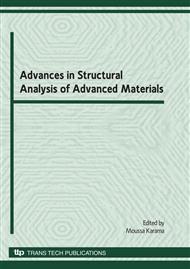p.1
p.9
p.19
p.29
p.37
p.49
p.63
p.73
Effect of Fiber Treatment on Fiber Strength and Fiber/Matrix Interface of Hemp Reinforced Polypropylene Composites
Abstract:
The use of natural fibers as reinforcement in composites is emerging. Several studies are underway to improve the mechanical characteristics of these fibers and its matrix interface properties for better load transfer. However, the treatments generally used are relatively expensive and complicated to apply. This work deals with the effect of new Fibroline process on tensile and interfacial properties of hemp fiber reinforced in polypropylene. Fibroline is a dry powder impregnation method which consists of submitting fibers and polymer powder under strong alternating electric field. Morphology and tensile properties of hemp fibers after different surface treatments (raw, dried, raw and Fibroline-treated, dried and Fibroline-treated) are evaluated. Interface properties of treated hemp fibers on polypropylene matrix are then characterized by fragmentation test of monofilament composites. Results showed the Fibroline treatment reduces the fiber mechanical properties but improves the load transfer efficiency due to random generation of surface cracks and better fiber/matrix adherence, respectively. For the case of dried and Fibroline-treated hemp fibers, large decrease in mechanical and interfacial properties was observed.
Info:
Periodical:
Pages:
1-8
Citation:
Online since:
May 2010
Authors:
Price:
Сopyright:
© 2010 Trans Tech Publications Ltd. All Rights Reserved
Share:
Citation:


